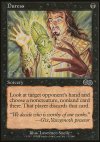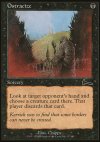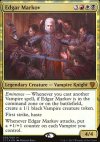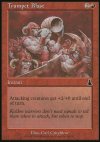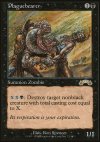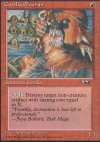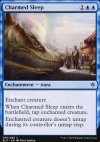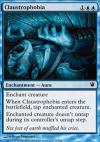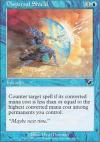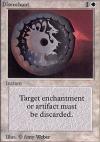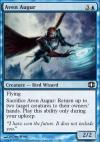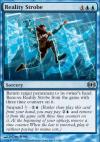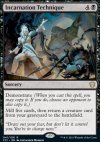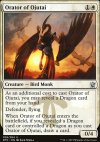|

MV anecdotes
| 1028 anecdotes trouvées |   |
Les deux cartes Duress et Ostracize, du bloc des éditions Urza's Saga, Urza's Legacy et Urza's Destiny, forment une paire.
Source (Duress)
Source (Duress)
La carte Fervor est une référence à Concordant Crossroads de par son effet, à la nuance qu'elle limite le bonus qu'elle offre aux créatures de son contrôleur.
Source (Fervor - "[...] it would be great to bring that feel over to the color that was supposed to give all your guys haste—red. The one change I made was to make it only affect your guys, because otherwise the card was usually only good in a deck where you were trying to be faster than your opponent.")
Source (Fervor - "[...] it would be great to bring that feel over to the color that was supposed to give all your guys haste—red. The one change I made was to make it only affect your guys, because otherwise the card was usually only good in a deck where you were trying to be faster than your opponent.")
Les deux cartes Lightbringer et Lawbringer, de l'édition Nemesis, forment une paire de "Color-Hosers". De plus leurs textes d'ambiance se font écho.
Le clan Dusken, représenté seulement par la carte Nearheath Stalker, est l'un des clans mineurs de vampires sur le Plan Innistrad.
Originellement représentées par les douze seigneurs qui ont accompli le rite d'Edgar Markov, seules quatre des douze lignées de vampires d'Innistrad sont encore aujourd'hui puissantes et actives (les Markov, Voldaren, Falkenrath et Stromkirk), tandis que trois ont entièrement disparu, et que les cinq restantes ne sont que des clans mineurs. Parmi eux, trois sont connus, représentés par très peu de cartes : les Domnathi, menés par Henrika, les Maurer de Strefan et les Dusken, ennemis des Maurer et pratiquement éradiqués par ceux-ci.
Source : MTG Plane Shift: Innistrad compatible with Dungeons & Dragons Tabletop RPG (Introduction - Vampires {introduction} - Vampires {Vampire Bloodlines} - Curse of Innistrad {introduction} - Strahd von Zarovich—Strefan Maurer - Rahadin and the Dusk Elves—The Dusken Line - Creatures and Encounters {Vampire Spawn.})
Originellement représentées par les douze seigneurs qui ont accompli le rite d'Edgar Markov, seules quatre des douze lignées de vampires d'Innistrad sont encore aujourd'hui puissantes et actives (les Markov, Voldaren, Falkenrath et Stromkirk), tandis que trois ont entièrement disparu, et que les cinq restantes ne sont que des clans mineurs. Parmi eux, trois sont connus, représentés par très peu de cartes : les Domnathi, menés par Henrika, les Maurer de Strefan et les Dusken, ennemis des Maurer et pratiquement éradiqués par ceux-ci.
Source : MTG Plane Shift: Innistrad compatible with Dungeons & Dragons Tabletop RPG (Introduction - Vampires {introduction} - Vampires {Vampire Bloodlines} - Curse of Innistrad {introduction} - Strahd von Zarovich—Strefan Maurer - Rahadin and the Dusk Elves—The Dusken Line - Creatures and Encounters {Vampire Spawn.})
Introduction a écrit :
The lord [...] is Strefan Maurer, who drank angel's blood alongside Edgar Markov and Olivia Voldaren centuries ago. His bloodline is small and mostly irrelevant to the larger world, but in the outland valleys of Stensia, he is the ultimate master.
Vampires {introduction} a écrit :
In their stately manor houses, sprawling courts, and towering castles, four great family lines of vampires [...]
Vampires {Vampire Bloodlines} & Curse of Innistrad {introduction} a écrit :
Innistrad's ancient history speaks of a human alchemist and healer named Edgar Markov, who sought to preserve his own life and the lives of his family. As old age began to claim him, he despaired [...] and turned to black magic. [...] the demon Shilgengar appeared to Markov and revealed a means by which he could achieve immortality: a dark ritual that involved drinking an angel's blood.
The vampires of Innistrad are all descended from twelve ancient sires—the congregation that participated in Markov's blasphemous ritual. Of these twelve bloodlines, four constitute the vast majority of Innistrad's vampires: Markov, Voldaren, Falkenrath, and Stromkirk.
The vampires of Innistrad are all descended from twelve ancient sires—the congregation that participated in Markov's blasphemous ritual. Of these twelve bloodlines, four constitute the vast majority of Innistrad's vampires: Markov, Voldaren, Falkenrath, and Stromkirk.
Curse of Innistrad {introduction} a écrit :
[... Of these twelve bloodlines, four constitute the vast majority of Innistrad's vampires: Markov, Voldaren, Falkenrath, and Stromkirk.] Three of the others have died out completely, while five are so few in number as to be irrelevant. One of those nearly irrelevant lines is that of Strefan Maurer, who rules a remote region in Stensia's outland valleys.
Strahd von Zarovich—Strefan Maurer a écrit :
[...] Strefan studied magic and forged a pact with the demon Shilgengar in return for the promise of immortality. After murdering his brother Sergei and drinking his blood, Strefan journeyed to Markov Manor and consulted with Edgar Markov. Together, they worked with Shilgengar to create the twelve bloodlines of vampires on Innistrad. Maurer Estate (Castle Ravenloft) was not spirited away to a demiplane—it was already on Innistrad [...]. And Strefan is not trapped here, so he is not seeking a successor in hopes of escaping.
Rahadin and the Dusk Elves—The Dusken Line a écrit :
[...] a line of vampires called the Duskens, named after their longlost progenitor Irska Dusken. Strefan killed Irska centuries ago and scattered the Duskens. Some were subjugated, while others went to live among the Bitterhearts.
Rahadin has been serving the Maurer family for many years, and even helped Strefan subjugate the rest of his line. He appears human rather than elflike, and dresses in red finery rather than wearing black armor.
Rahadin has been serving the Maurer family for many years, and even helped Strefan subjugate the rest of his line. He appears human rather than elflike, and dresses in red finery rather than wearing black armor.
Creatures and Encounters {Vampire Spawn.} a écrit :
[...] the infamous twins of Maurer Estate, two young girls named Ruby and Carmine. The two enjoy pretending to be helpless young girls, lost and alone, in order to get close to their prey.
Les cinq cartes Vessel of Ephemera, Vessel of Paramnesia, Vessel of Malignity, Vessel of Volatility et Vessel of Nascency, de l'édition Shadows over Innistrad et illustrées par Kieran Yanner, forment un cycle appelé "Vessel".
Le texte d'ambiance de la carte Shadow of Doubt fait référence à l'expression anglaise "Ignorance Is Bliss", qui peut se traduire en français par l'expression "Bienheureux sont les pauvres d'esprit" mais qui n'a cependant pas la même origine.
Le texte d'ambiance en français ne rend pas cette expression directement : "Vous êtes peut-être innocent, mais ce sont mes mains qui sont pleines."
Le texte d'ambiance en français ne rend pas cette expression directement : "Vous êtes peut-être innocent, mais ce sont mes mains qui sont pleines."
La carte Plaguebearer est une référence à Gorilla Shaman de par ses force et endurance et son effet, transposé d'un artefact à une créature.
Le jeton Halfling est dans sa version anglaise une "Tolkien Creature" (et non pas une "Token Creature"), en clin d'œil au nom de J. R. R. Tolkien qui met en scène ces personnages dans le roman du Seigneur des anneaux.
Les dix cartes Gwaihir the Windlord, The Mouth of Sauron, Mauhúr, Uruk-hai Captain, Strider, Ranger of the North, Butterbur, Bree Innkeeper, Denethor, Ruling Steward, Bilbo, Retired Burglar, Old Man Willow, Théoden, King of Rohan et Arwen Undómiel, de l'édition The Lord of the Rings: Tales of Middle-earth, forment un cycle de créatures légendaires bicolores peu communes soutenant chacune un archétype de formats limités.
Source 1 (Limited Archetypes) - Source 2 ("Draft, as an example, had a big influence on the uncommon gold cards that model Draft archetypes")
Source 1 (Limited Archetypes) - Source 2 ("Draft, as an example, had a big influence on the uncommon gold cards that model Draft archetypes")
Citation :
As with every set, the Set Design team puts together a list of the main draft archetypes. Normally, we default to the ten two-color pairs, and LTR doesn't deviate from that. Here's what each color pair is up to:
(Note: I'm going to use "typal" a few times in this section. That's an internal way that we refer to cards that care about creature type.)
White-Blue: This archetype is a midrange deck often using evasion as the win condition with a "draw a second card" theme.
Blue-Black: This archetype is a controlling amass deck. It has a milling aspect, allowing you to mill yourself for gain or the opponent to win. It also has a light Human typal element.
Black-Red: This archetype is an aggressive amass deck. It has a sacrifice component as well as an Orc and Goblin (as a batch) typal element.
Red-Green: This archetype is a ramp "power matters" deck pairing larger red creatures with green Treefolk. It also dips into the wild creature element of the set.
Green-White: This archetype is an aggressive Hobbit deck that makes use of Food tokens.
White-Black: This archetype is a "legendary creatures matter" deck that makes use of the Ring tempts you mechanic. It has more legendary creatures and a sacrifice component. The Ring helps you splash a bit more than other archetypes.
Blue-Red: This archetype leans on a Wizards theme and has an "instants and sorceries matter" center. It's a control archetype that rewards you for casting a lot of spells.
Black-Green: This archetype has a life and death theme. It sacrifices and regrows cards. It's the other archetype that makes major use of Food tokens.
Red-White: This archetype is a go-wide Humans deck. It ranges from aggro to midrange depending on what cards you draft.
Green-Blue: This archetype is a tempo Elf deck. It has some Elf typal elements and rewards for scrying.
(Note: I'm going to use "typal" a few times in this section. That's an internal way that we refer to cards that care about creature type.)
White-Blue: This archetype is a midrange deck often using evasion as the win condition with a "draw a second card" theme.
Blue-Black: This archetype is a controlling amass deck. It has a milling aspect, allowing you to mill yourself for gain or the opponent to win. It also has a light Human typal element.
Black-Red: This archetype is an aggressive amass deck. It has a sacrifice component as well as an Orc and Goblin (as a batch) typal element.
Red-Green: This archetype is a ramp "power matters" deck pairing larger red creatures with green Treefolk. It also dips into the wild creature element of the set.
Green-White: This archetype is an aggressive Hobbit deck that makes use of Food tokens.
White-Black: This archetype is a "legendary creatures matter" deck that makes use of the Ring tempts you mechanic. It has more legendary creatures and a sacrifice component. The Ring helps you splash a bit more than other archetypes.
Blue-Red: This archetype leans on a Wizards theme and has an "instants and sorceries matter" center. It's a control archetype that rewards you for casting a lot of spells.
Black-Green: This archetype has a life and death theme. It sacrifices and regrows cards. It's the other archetype that makes major use of Food tokens.
Red-White: This archetype is a go-wide Humans deck. It ranges from aggro to midrange depending on what cards you draft.
Green-Blue: This archetype is a tempo Elf deck. It has some Elf typal elements and rewards for scrying.
Les cartes Alchemist's Gambit et Chance for Glory sont des références à Final Fortune de par leur effet.
Les cartes Warrior's Oath et Last Chance sont des réimpressions fonctionnelles de Final Fortune, à la seule différence d'être un rituel au lieu d'un éphémère.
Les deux cartes Syphon Mind et Syphon Soul, de l'édition Onslaught, forment une paire. En fait la première est une référence à la seconde, sachant que Syphon Soul est parue à l'origine dans l'édition Legends.
Les six cartes Reward the Faithful, Dispersal Shield, Rush of Knowledge, Cabal Conditioning, Torrent of Fire et Accelerated Mutation, de l'édition Scourge, forment un cycle.
La carte Quiet Disrepair est une référence à Disenchant de par son nom, son coût de mana, son effet et enfin son illustration.
La carte Imperial Mask est une référence à Ivory Mask de par son nom, son effet, adapté pour le jeu multijoueurs, et enfin son illustration.
Les cinq cartes Augur il-Vec, Aven Augur, Augur of Skulls, Emberwilde Augur et Llanowar Augur, de l'édition Future Sight, forment un cycle appelé "Augur".
Les cinq cartes Chronomantic Escape, Reality Strobe, Festering March, Arc Blade et Cyclical Evolution, de l'édition Future Sight, forment un cycle.
Les cartes Inspiring Refrain et Rousing Refrain (voir aussi cette anecdote), Venture Forth, Charnel Serenade et Suspended Sentence parues ensuite font référence à ce cycle.
Search ~ Texte : Exile "with three time counters on it." &qu...
Les cartes Inspiring Refrain et Rousing Refrain (voir aussi cette anecdote), Venture Forth, Charnel Serenade et Suspended Sentence parues ensuite font référence à ce cycle.
Search ~ Texte : Exile "with three time counters on it." &qu...
Les cinq cartes Kindred Boon, Kindred Discovery, Kindred Dominance, Kindred Charge et Kindred Summons, de l'édition Commander 2017, forment un cycle appelé "Kindred".
Les cinq cartes Benevolent Offering, Intellectual Offering, Infernal Offering, Volcanic Offering et Sylvan Offering, de l'édition Commander 2014, forment un cycle appelé "Offering".
Les cinq cartes Excavation Technique, Replication Technique, Incarnation Technique, Creative Technique et Healing Technique, de l'édition Commander 2021, forment un cycle appelé "Technique".
Les cinq cartes Scaleguard Sentinels, Orator of Ojutai, Silumgar's Scorn, Foul-Tongue Invocation et Draconic Roar, de l'édition Dragons of Tarkir, forment un cycle.
| 1028 anecdotes trouvées |   |






 Edge of Eternitties
Edge of Eternitties Final Fantasy
Final Fantasy Tarkir: Dragonstorm
Tarkir: Dragonstorm Aetherdrift
Aetherdrift Foundations
Foundations Duskmourn
Duskmourn Bloomburrow
Bloomburrow